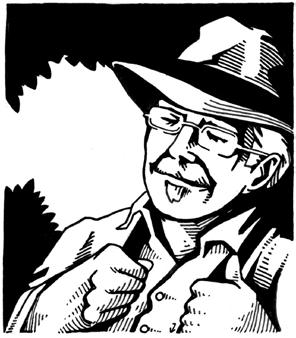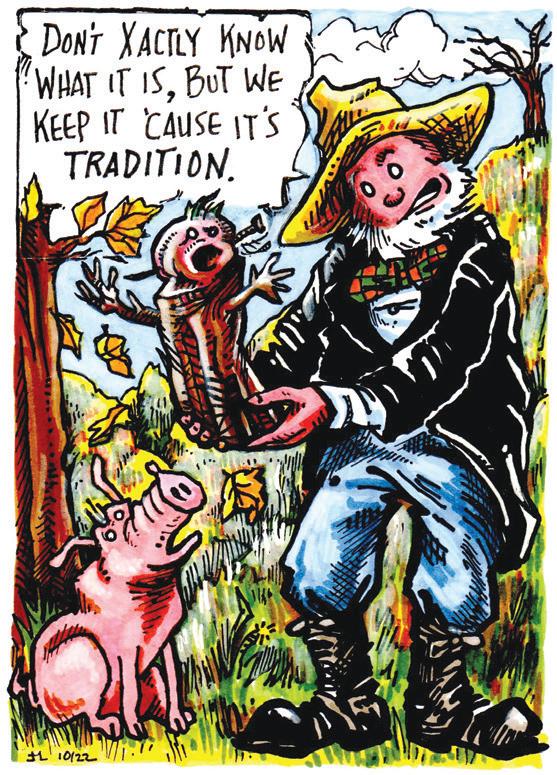
5 minute read
Musings: Traditions
~by Mark Blackwell
“Tradition is just peer pressure from dead people.” —Unknown
Advertisement
We’re coming into that time of the year where we surrender a fair amount of “free will” to “tradition.” Thanksgiving is coming up and we hardly get the last piece of pumpkin pie finished before the Christmas shopping days countdown begins. Undergirding the whole season of festivities is “tradition.”
But what is tradition?
Pretty much it is “the way we’ve always done it.”
Family is where we receive our first lessons in tradition. Most of us are taught the correct way that the silverware goes in the drawer; knives first, then forks, then soup spoons (or the reverse). There is an order that was handed down from one of your grandmas, and probably great or even great-great grandmas—unless you grew up in an anarchist household where you just threw everything in with total abandon.
The big, widely shared traditions generally start taking over our lives around Thanksgiving and Christmas. Thanksgiving is primarily a food and family holiday, whereas Christmas comes with a whole trainload of baggage.
Our American Thanksgiving is a secular holiday that can be traced back to 1621 when a group of English refugees were saved by the indigenous folks that discovered them. According to what many of us learned in school, certain natives of Massachusetts taught the Pilgrims how to plant and grow corn, squash, and beans. When harvest time came around the Pilgrims decided to have a celebration to thank the Lord for their good fortune.
They invited members of the local native tribe to a feast that lasted three days. We assume that they had corn, beans, and squash along with fish and wild game. In modern times we commemorate this feast by cooking up some corn, boiling down beans, making pumpkin pie (it is in the squash family), plus roasting a turkey, mashing potatoes, and whipping up some tangy cranberry sauce.
It can be a three-day event, but most folks only get one or maybe two days off from work to celebrate. It takes one day to prepare and cook the feast, one day to gorge on the food, and one day to recover from gluttony.
Christmas on has its roots in religion, but has been co-opted into a full-blown secular holiday in this country.

Christmas (Christ Mass) was instituted to celebrate the birth of Jesus, the founder of Christianity, but now it is a worldwide secular and religious holiday.
In the good old USA, Saint Nicholas, a 3td Century Greek, Christian bishop, known for his generosity, has morphed into the Santa Claus we know today. Manger scenes compete with Frosty the Snowman and Rudolph the Red Nosed Reindeer. Christmas carols get eclipsed by “Jingle Bells” and “Walking in a Winter Wonderland.” Occasionally, the sacred and the secular combine in minor spectacles like the annual TV presentation of “A Charlie Brown Christmas” ( a holiday viewing tradition in my family).
The Christmas holiday has been successful in absorbing an array of pagan traditions.
Practically every home displays an evergreen Christmas tree. But long before the birth of Jesus, various pagan tribes of Europe would decorate their homes with evergreen boughs at mid-winter. The Romans adorned their temples with evergreen branches during their winter solstice celebration of Saturnalia. The evergreens were likely reminders of life and fertility in the dark days of winter.
By the 16th Century Germans were bringing whole fir trees into the house and decorating them with cookies, apples, and nuts. The practice spread with emigrating Germans and didn’t become popular until the Victorian era.
Queen Victoria and Prince Albert of England both had German ancestry and introduced decorated Christmas trees to Windsor castle in the mid-19th Century. The practice soon caught on with the populace. America was quick to pick up the idea and improve on it.
In 1843, Charles Dickens published his story “A Christmas Carol” which fleshed out the trappings of a Victorian Christmas with its description of Ebenezer Scrooge’s nephew Fred’s Christmas Eve party and the Cratchit family’s Christmas feast.
Now, back to Saint Nicholas. In this country the legend comes to us from the Dutch who settled New Amsterdam in the 1600s, now known as New York. They brought with them Sinterklaas, their version of Saint Nicholas. It wasn’t long before the name became Americanized as Santa Claus. This Santa Claus was first described in the 1823 poem by Clement Moore, “Twas the Night before Christmas” but it wasn’t until the 1860s that cartoonist Thomas Nast produced the first portrait of the Santa Claus recognized today.
With pagan evergreens, Moore’s poem about a visit from St. Nick, Dickens’ story of Ebenezer Scrooge and the Cratchit family, and finally Nast’s depiction of Santa, we have the basic elements for a traditional Christmas.
Brown County is a place with its own set of traditions, and celebrating Christmas is top of the list. We’re coming up on the season when our little village goes all out with lights and trees and decorations and shops full of Christmas gifts to welcome visitors. And for those who may be looking for a “silent night,” nothing is better than a walk in the woods when nature decorates it with a new fallen snow.
Any way you look at it, Brown County is a wonderful place to practice your own traditions, or maybe make some new ones.









